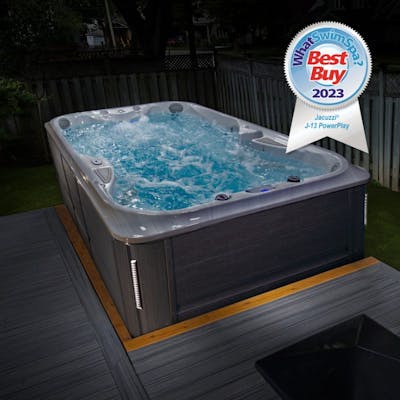The Jacuzzi® Swim Spa Collections
Browse Swim Spa Collections

PowerPro™ Swim Spa Collection
From beginners to triathletes, the Jacuzzi® PowerPro™ Swim Spa collection offers the ultimate counter current swim, blending advanced aquatic technology with the healing power of Jacuzzi® PowerPro™ Jets and exclusive Infrared technology.

PowerActive™ Swim Spa Collection
Featuring our exclusive Infrared technology, PowerActive™ Swim Spas are perfect for advanced hydrotherapy, general swimming, aqua fitness and all-round family fun–the ideal alternative to a traditional swimming pool for all-year-round enjoyment.

PowerPlay™ Swim Spa Collection
Get active and stay active with the PowerPlay™ J-13™ Swim Spa–an excellent choice for family fun, exercise, and entry-level swimming. Plus, a mix of bench seats and hydromassage seats offer up to nine options to enjoy Jacuzzi® hydrotherapy.

Infrared Technology Swim Spas
Jacuzzi® PowerActive™ and PowerPro™ swim spas combine hydrotherapy and wave technology with the convenience of a home pool, utilising exclusive Infrared technology for superior wellness benefits. Experience quality performance year-round.
Why buy a Jacuzzi® swim spa?
Featured Swim Spas
Helpful Info
Yes, Infrared therapy and Red Light therapy can help after swim training by providing the following benefits:
Regeneration:
Infrared and Red light therapy can promote tissue repair and regeneration, helping the body recover from the physical stress of swim training more quickly and effectively.
Pain relief:
Both therapies have been shown to reduce inflammation and alleviate muscle soreness, providing natural pain relief after intense swim training.
Stress relief:
The relaxation-inducing effects of infrared and red light therapy can help relieve stress and promote a sense of calm and well-being after a demanding swim training session.
Improved range of motion:
By reducing muscle tension and promoting blood circulation, infrared and Red Light therapy can help improve flexibility and range of motion, allowing swimmers to move more freely and with less discomfort.
It's important to note that the specific benefits experienced may vary from individual to individual.
Our FX-IR seat is available in two of our swim spa collections:
- Jacuzzi® PowerActive™ swim spa collection
- Jacuzzi® PowerPro™ swim spa collection
- Rejuvenation: Infrared and Red Light therapy can help rejuvenate the body by promoting cellular regeneration and collagen production, resulting in improved skin tone, texture, and overall appearance.
- Ease joint pain: Both therapies have been shown to alleviate joint pain and inflammation, making them beneficial for individuals with conditions such as arthritis or joint stiffness resulting from swim training.
- Better sleep: The relaxation-inducing effects of Infrared and Red Light therapy can help improve sleep quality, aiding in recovery and promoting overall well-being.
- Restore and relax: The soothing warmth of Infrared therapy combined with the calming effects of Red Light therapy can help restore and relax the body and mind after a swim, reducing physical and mental fatigue.
- Individual experiences may vary*
Yes, Infrared and Red Light therapy is safe. To ensure safety to our customers, Jacuzzi has tested this product which has gained clinical validation and FDA approval as a medical device.
The short answer is yes. The patented design is engineered with full-spectrum light therapy with Infrared Light wavelength of 850nm and Red Light wavelength of 660nm. It is designed to offer full-body benefits that soothe, relax and rejuvenate.
On Jacuzzi® PowerActive™ and PowerPro™
Swim Spas, Near-Infrared waves are used to penetrate below the skin into the deeper muscle tissue specifically in the lower back area. You can select the Infrared and Red Light therapy session from the topside control and it will run for a 20-minute cycle. Its integration into the Jacuzzi® SmartTub® System and app allows you to keep track of your Infrared and Red Light therapy sessions.
Your body will only experience the sensation of warmth from being in a hot tub or swim spa, you will only feel the benefits of the therapy, not the actual light waves.
Just like with the recommended dosage of vitamins, more does not always mean better. Shorter sessions spread out over several days yield the most beneficial outcomes. Longer sessions do not necessarily provide better outcomes.
You may start noticing positive changes after a few consecutive days of therapy. These changes can be things such as reduced pain or an overall sense of improved well-being. Consistent practice plays a crucial role in experiencing the benefits of this therapy.
















